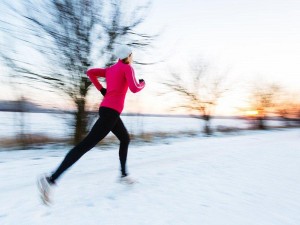 By Sam Hutchison CES, CPT, NASM-CPT
By Sam Hutchison CES, CPT, NASM-CPT
The seasons have changed, and for some of us it means below freezing temperatures and snow on the ground—not the most ideal conditions for exercising and physical activity. Fortunately, you don’t have to limit yourself to treadmills, ellipticals and recumbent bikes, exercising outdoors is still a plausible option with some foresight and a plan of action. If you dress properly and follow some easy strategies, you can survive the frigid forefront and exercise at your own discretion.
As humans, our bodies aren't accustomed to cold climates and take longer to adapt to the cold compared to warmer environments. Biologically humans weren’t designed to live in cold climates; humans lack heavy fur coats and a thick lining like many animals living in colder climates thus making heat production and insulation more difficult. Wearing protective layers is essential to preventing not only a decline in exercise performance but more serious issues such as hypothermia and frostbite.
The Cold's Effect on Performance
Exercising in cold climates can have inhibitory effects on both cardiorespiratory and strength performance. When exposed to cold environments, the body reduces blood flow to the skin and extremities via vasoconstriction to prevent heat loss and maintain the temperature of the body’s core and vital organs. Due to vasoconstriction and blood cooling, aerobic energy components such as fat and oxygen aren't as efficiently transported to the muscles for energy production (1). Fuel sources that are typically used for higher intensity training, like muscle glycogen, begin to be used as a replacement, leaving less fuel for later and an earlier onset of fatigue results (2).
When muscle temperatures fall below a certain point, the time for muscles to contract and the amount of muscles recruited (motor unit recruitment) for an activity is compromised (3). This limits the amount of force and power typically seen at more favorable temperatures. If not taken seriously, a decline in performance can lead to frustration and possible injury.
5 Tips for Training in The Cold
Here are some tips you’ll want to consider implementing before stepping outside to exercise or train. It may not seem like much, but following these tips can make your workouts more enjoyable and ultimately safer.
1. Wear layers: It’s difficult to judge just what to wear when planning on exercising outdoors in the cold. Wearing layers allows you to easily adjust and remove layers of extra insulation as your temperature increases.
2. Remove wet clothing: Water conducts heat much faster than air, so your body loses heat more quickly when clothes are wet. Remove wet clothing to stay properly insulated.
3. Be selective about fabrics: Keeping the skin dry is one of the first layers of defense against the cold. Use a moisture wicking fabric next to the skin; synthetic fabrics and wool dry more quickly than their cotton counterpart. Additional heat can also be lost through wind chill, so make use of wind breaking material on outer layers.
4. Hats, footwear and gloves: As stated earlier, it is important to prevent heat loss and make sure there is optimal blood flow to vital organs and working muscles. The hands, feet, and especially the head are vulnerable areas for heat loss and should be kept insulated. A pair of running gloves, insulating socks, training shoes and a wool/fleece hat can help prevent heat loss.
5. Hydrate, Hydrate, Hydrate: Just like in the heat, it is important to hydrate when cold. You might not realize that you can become dehydrated in the cold since you are sweating less. As you breathe in cold air your body must humidify and warm the inhaled air as it travels to the lungs. This process can dehydrate the body. Drinking a warm beverage before, during and after activity can help fight dehydration and warm the body (4).
It’s unfortunate that we can’t control the weather; a 75-degree day would be a nice break to have in the middle of December. Regardless of your sport or exercise routine, it is important to be able to adapt to changes in weather and develop a plan of action to prevent injury and a decline in performance, even if that might mean taking your training indoors. The winter months and holiday season are not the time to get out of shape. Try following these five simple suggestions and you might just feel like you are working out in that 75-degree weather that you crave.
References
1. Farrell PA, Joyner MJ, Caiozzo VJ. ACSM’s Advanced Exercise Physiology 2nd ed. Baltimore, MD: Lippincott, Williams & Wilkins; 2012.
2. Castellani JW, Young AJ. Health and performance challenges during sports training and competition in cold weather. Br Journ Sport Med (2012);46:788-791.
3. Rome LC. Influence of temperature on muscle recruitment and muscle function in vivo. Am Jorurn Physiol (1990); 259: 210-222.
4. Koskela HO. Cold air-provoked respiratory symptoms: the mechanisms and management. Int Journ of Circ Health (2007); 66(2): 91-100.











